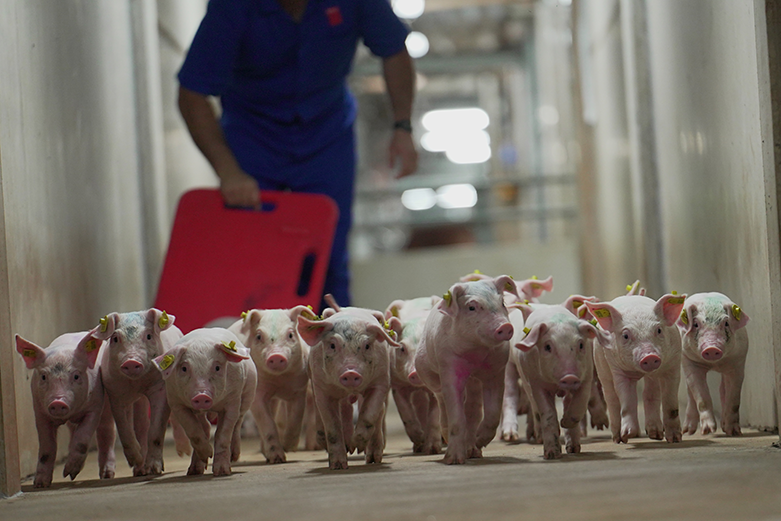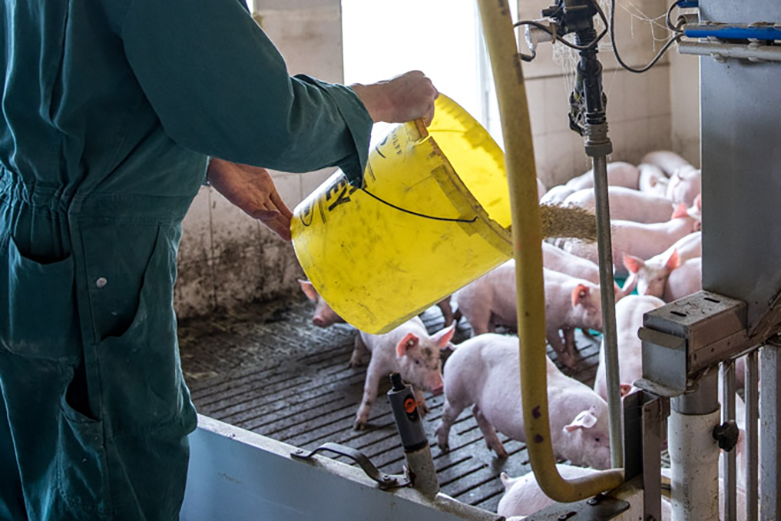These drivers impact the success of an operation.
The cornerstone is the first stone set in a masonry foundation. All other stones are set in reference to this stone, and in turn, the cornerstone determines the position of every other stone in the structure.
Think about this concept in terms of a wean-to-finish operation. What needs to be set in place first to ensure success later? Based on research and applied knowledge, PIC identified four cornerstones or drivers of wean-to-finish excellence.
- Quality weaned pigs
- Nutrient intake
- Health status
- Marketing strategy

All four drivers have equal impact. To maximise success, address all four drivers equally and consistently. If one driver falters, it diminishes the success of the other drivers, and ultimately profit potential.
Quality weaned pigs
The pig entering the building has a foundational impact on end results. All pigs received should be quality weaned pigs. Quality weaned pigs have all the following characteristics:
- Healthy: The sow unit health status is stable, and the individual pig is healthy
- Thrifty: The pig has the ability and willingness to eat, absent of phenotypic defects
- Good combination age/weight: The pig is an adequate weight and age for weaning
- Consistency: Pigs born and weaned are uniform
Weaning management practices to help achieve quality weaned pigs:
- At weaning, screen all piglets for quality weaned pig characteristics
- Wean between 21 (follow current welfare code PG.AH.13.a in this case, see footnote) to 28 days (average 26) with a minimum weight of 6kg
- Respect farrowing room integrity. DO NOT wean smaller/younger pigs to complete groups nor delay pigs with poor growth rate
- Ensure pig flow is large enough to fill a wean-to-finish building quickly
Goal of >95% weaning weight efficiency. Ratio example: The weight at 21 days old should be 6.1 kg (as company goal) divided by real weight (e.g. 5.7 kg), in this example, the weaning weight efficiency is 93% (5.7/6.1).
Health status
A healthy wean-to-finish pig will grow quickly, efficiently and without much intervention. Maximise pig health by following biosecurity practices, providing a comfortable barn environment, boosting their immune system, and enabling them to overcome disease challenges more easily.
Management practices critical to maximizing health status:
- Prevent disease challenges. Create and implement a strict biosecurity plan and strengthen the immune system in growing pigs.
- Frequent staff communication. Ensure 100% adherence to biosecurity protocols to prevent on farm disease entry. Hold regular staff meetings to review protocols and explain why each protocol matters.
- Proper pig management. Reduce age spread and sow sources per production flow, avoid mixing pigs flows and use ‘All In-All Out’ flow management.
- Monitor and diagnose properly. Implement robust disease monitoring and implement an effective diagnostic program to detect health challenges early.
- Consult with herd veterinarian to review health and diagnostics from previous groups to ensure proper vaccinations are in place.
Nutrient intake
An adequate diet, with proper feed and water access, is critical for growth in wean-to-finish. Ensure access to feed and drinkers to prevent stress that would lead to compromised health and growth.
Also, maintain a proper barn environment (temperature and humidity targets) to encourage feed and water intake, avoid burning calories to maintain body temperature and minimise performance losses.
Management practices to ensure nutrient intake:
- Watch for changes in water and feed consumption as this is a strong indicator of pig performance and potential health threats. The ratio of water consumption to feed intake should be between 2:1 and 3:1.
- Ensure ventilation system settings match pig requirements.
- Ensure adequate water access through proper drinker positioning and enough drinkers/pig.
- Check water flow and water quality regularly.
- Ensure adequate feed quality, feeder position and feeder space/pig as pigs grow.
Marketing strategy
Don’t let your marketing strategy be an afterthought. Identify the right marketing strategy and consistently apply the approach to achieve overall wean-to-finish success. Without the right marketing approach, efforts applied to the other drivers will be lost.
Management practices to ensure a consistent marketing strategy:
- Ensure >94% Full-Value Pigs
- Properly select slaughter pigs for the right truck at the right time
- Reduce sorting errors and market variation (<10-12%)
- Manage transport carefully to minimise animal stress and ensure safety (Death On Arrival <0.13% and non-ambulatory injured/non-ambulatory non-injured <0.15%)
PG.AH.13.a
Piglets may be weaned up to 7 days earlier if moved into specialised housing which:- has been emptied and thoroughly cleaned and disinfected – is separate from housing where sows are kept



